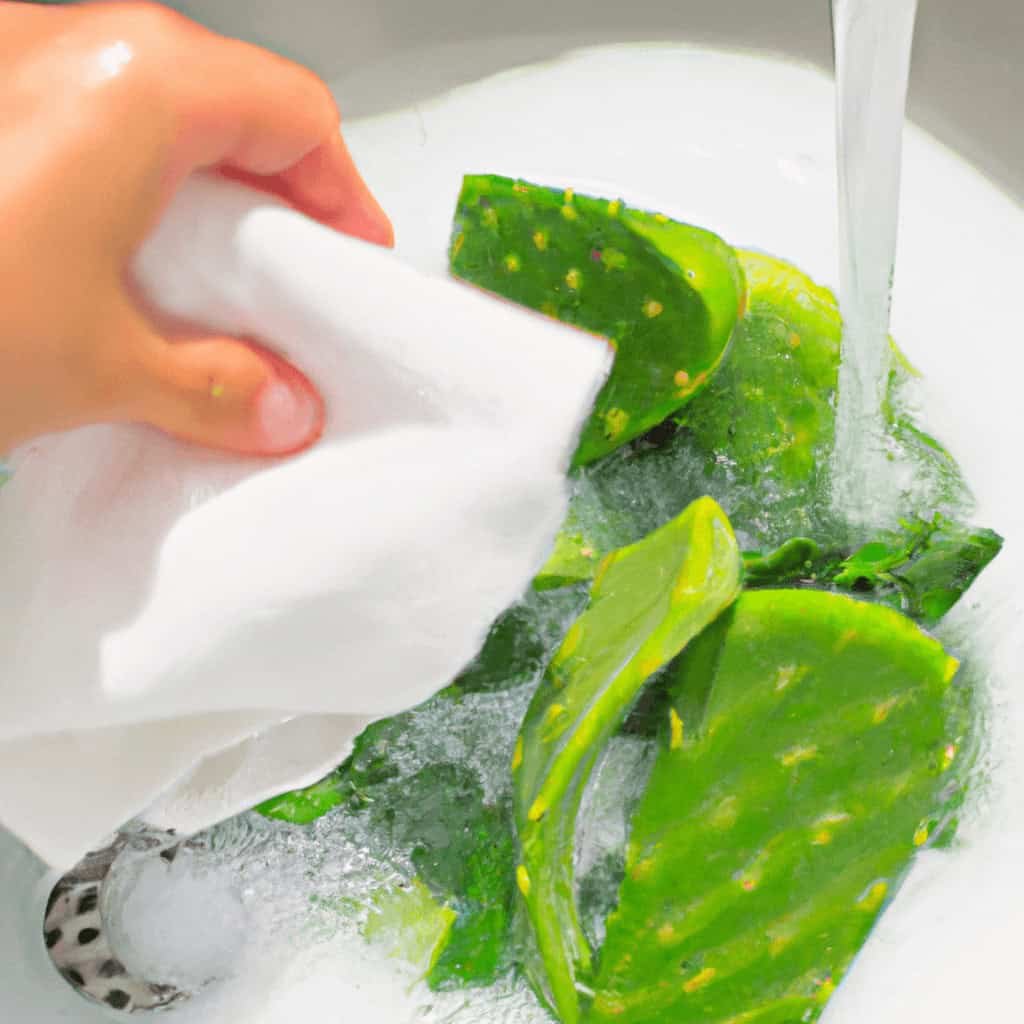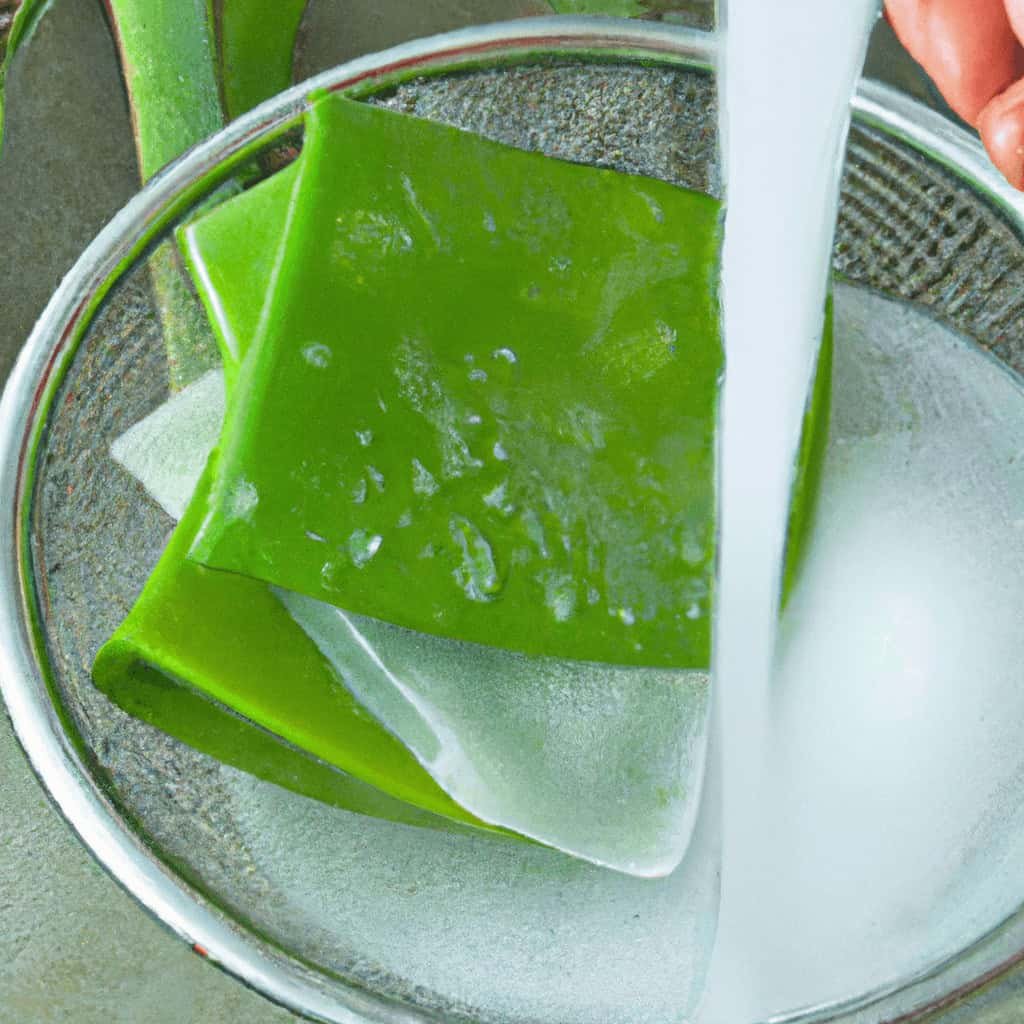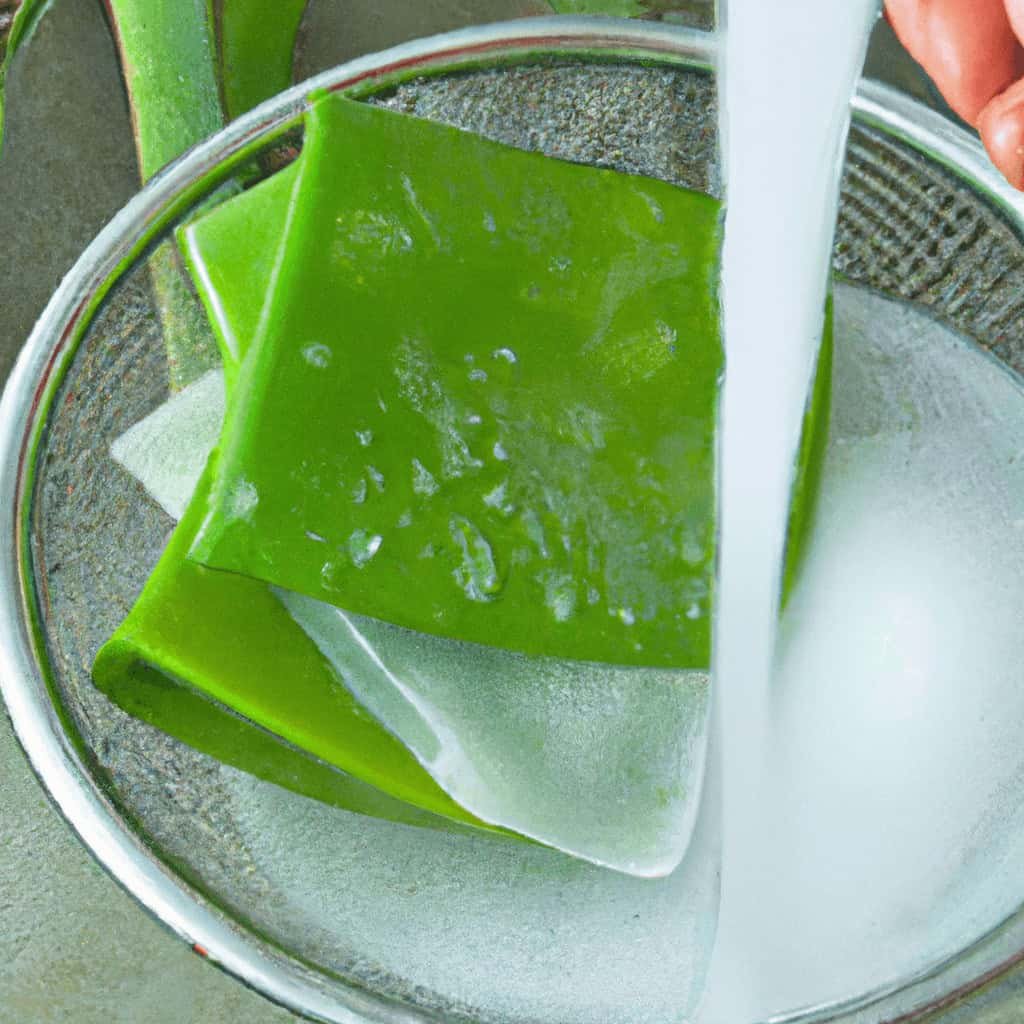If you’re a fan of Mexican cuisine or looking to add a nutritious ingredient to your meals, nopal, also known as prickly pear cactus, should be on your radar. But before you can start cooking with it, it’s important to know the best way to clean and wash nopal for recipes. With its spiky appearance, you might be wondering how to handle this unique ingredient properly. In this article, we’ll guide you through the process, providing you with tips and techniques to ensure your nopal is thoroughly cleaned and ready to be transformed into a delicious dish. So, let’s get started on this culinary adventure and unlock the secrets of preparing nopal!

Preparing the Nopal
When it comes to preparing nopal, it is important to start with the right one. Make sure to select fresh, vibrant green nopales that are firm to the touch. Avoid any that look wilted or discolored, as they may not be suitable for consumption. Additionally, if possible, try to choose nopal that is organically grown to minimize the presence of pesticides or other chemicals.
Selecting the Right Nopal
Choosing the right nopal is the first step in ensuring a successful cleaning process. Look for nopales that are free from blemishes, bruises, or signs of decay. These indicators can be a sign that the nopal is not fresh and may affect the overall taste and quality of your dishes. Opt for ones that are firm to the touch and have a vibrant green color.
Handling Nopal Safely
Nopal, like many other cactus plants, has spines that can cause irritation or injury if not handled properly. To handle nopal safely, it is recommended to wear protective gloves to avoid any contact with the spines. Additionally, use tongs or a fork to hold the nopal while cleaning and avoid touching your face or eyes during the process.
Removing the Spines
To remove the spines from the nopal, start by trimming off the edges and any visible spines using a sharp knife. Then, gently scrape the surface of the nopal with the back of the knife to remove any remaining spines. Be sure to work carefully and thoroughly to ensure all the spines are removed. Once the spines are removed, you can proceed to the washing techniques.
Washing Techniques
Properly washing the nopal is crucial to remove any dirt, debris, or slimy substance that may be present. There are several washing techniques that can be used, depending on personal preference and the level of cleanliness desired.
Rinsing with Water
The simplest and most basic method for washing nopal is by rinsing it with water. Hold the nopal under a stream of cool water and rub the surface gently to remove any dirt or debris. Pay extra attention to the crevices and folds of the nopal to ensure thorough cleaning. Once rinsed, inspect the nopal for any remaining dirt or debris before proceeding.
Using Salt and Lemon
For a more thorough cleaning, you can opt for a salt and lemon wash. Fill a bowl or basin with water and add a generous amount of salt and the juice of one lemon. Stir the mixture to dissolve the salt, then submerge the nopal in the solution and rub it gently to remove any dirt or slimy residue. This method not only cleans the nopal but also helps to reduce its natural sliminess.
Soaking in Vinegar Solution
Another effective method for washing nopal is by soaking it in a vinegar solution. Fill a bowl or basin with water and add approximately one cup of white vinegar. Submerge the nopal in the solution and let it soak for about 15 minutes. The acidity of the vinegar helps to break down any slimy residue and leaves the nopal clean and ready for cooking.
Removing the Gooey Substance
Nopal naturally produces a gooey substance known as mucilage, which can make it unpleasant to eat if not properly removed. Here are a few methods to remove the gooey substance from the nopal.
Scraping with a Knife
One method for removing the gooey substance is by scraping it off with a knife. Hold the nopal firmly and use the side of a sharp knife to scrape away the slimy layer. Be sure to work gently to avoid damaging the nopal. Once the slimy layer is removed, rinse the nopal under water to remove any remaining residue.

Blanching the Nopal
Blanching is an effective technique to both remove the gooey substance and soften the nopal. To blanch the nopal, bring a pot of water to a boil and submerge the nopal for about 5 minutes. This will help to break down the mucilage and make it easier to scrape off. After blanching, rinse the nopal under cool water to stop the cooking process and remove any residue.
Brushing with Olive Oil
An alternative method to remove the gooey substance is by brushing the nopal with olive oil. Simply apply a thin layer of olive oil to the surface of the nopal and let it sit for about 10 minutes. The oil will help to loosen the mucilage, making it easier to wipe away. Afterward, use a clean cloth or paper towel to wipe off the slimy residue.
Methods for Cleaning Debris
In addition to removing the gooey substance, it is important to clean nopal from any debris or impurities. Here are a few methods to ensure a thorough cleaning.
Using a Soft Brush
One way to clean nopal from debris is by using a soft brush. Gently scrub the surface of the nopal with the brush, paying attention to any crevices or folds. This method is particularly effective for removing dirt or tiny particles that may be stuck to the surface. After brushing, rinse the nopal under water to remove any loosened debris.
Scrubbing with a Cloth
If you prefer a hands-on approach, you can use a clean cloth to scrub the nopal. Wet the cloth and use it to rub the nopal, paying attention to all areas to ensure thorough cleaning. This method is effective for removing dirt and debris and allows for better control and precision. After scrubbing, rinse the nopal thoroughly to remove any residue.

Picking Out Debris by Hand
For larger debris or impurities, you can simply pick them out by hand. Inspect the nopal carefully and remove any visible particles or dirt manually. Be sure to work gently to avoid damaging the nopal. After picking out debris, rinse the nopal under water to remove any remaining residue.
Drying Techniques
After the nopal has been cleaned, it is important to dry it properly before storage or cooking. Here are a few drying techniques to consider.
Air Drying
One simple and effective way to dry cleaned nopal is by letting it air dry. Place the nopal on a clean surface or hang it using a string, allowing it to dry naturally. Make sure to place the nopal in a well-ventilated area and avoid direct sunlight, as excessive heat can affect its quality. Once dry, the nopal can be stored or used in cooking.
Using a Paper Towel
If you prefer a quicker drying method, you can use a paper towel to pat the nopal dry. Gently press the paper towel against the surface of the nopal to absorb any remaining moisture. This method is especially useful if you plan to cook the nopal immediately after cleaning.
Using a Salad Spinner
For a more efficient and thorough drying method, you can use a salad spinner. Place the cleaned nopal in the spinner and spin it at a moderate speed to remove excess water. This method is particularly effective for removing moisture from the crevices and folds of the nopal, ensuring a faster drying process.

Storing the Cleaned Nopales
Once the nopal is cleaned and dried, it is important to store it properly to maintain its freshness and quality. Here are a few methods for storing cleaned nopales.
Refrigerating in a Sealed Container
One common method for storing cleaned nopales is by refrigerating them in a sealed container. Place the dried nopal in an airtight container or ziplock bag and store it in the refrigerator. This method helps to preserve the freshness and texture of the nopal for a few days.
Freezing for Longer Shelf Life
To extend the shelf life of cleaned nopales, you can freeze them. Place the dried nopal in a freezer-safe bag or container and store it in the freezer. This method allows you to keep the nopales for several months without compromising their quality. When ready to use, simply thaw the frozen nopal before cooking.
Blanching and Preserving in Jars
An alternative method for long-term storage is by blanching and preserving the cleaned nopales in jars. After blanching the nopal, pack them into sterilized jars and cover them with boiling water. Add a pinch of salt or a few drops of vinegar to each jar for preservation. Seal the jars tightly and store them in a cool, dark place. This method allows you to enjoy preserved nopales for an extended period.
Tips and Tricks
Here are some tips and tricks to enhance your nopal cleaning experience.

Wearing Gloves for Spine Removal
To protect your hands from the spines while removing them from the nopal, it is advisable to wear protective gloves. This will prevent any potential irritation or injury and make the process more comfortable and safe.
Using Tongs to Handle Hot Nopales
When blanching or cooking the nopal, it may become hot and difficult to handle. To avoid any burns or accidents, use tongs or a fork to handle the hot nopales. This will ensure your safety and make the cooking process more manageable.
Adding Baking Soda for Stubborn Residue
If you encounter stubborn residue or sliminess during the cleaning process, adding baking soda to your cleaning solution can help. Simply mix a tablespoon of baking soda with water or vinegar and use it to scrub the nopal. The baking soda acts as a natural cleaning agent and can effectively remove tough residue.
Preserving the Health Benefits
To ensure you reap the maximum health benefits from nopal, consider the following tips.
Choosing Organic Nopales
To minimize exposure to pesticides or other chemicals, it is recommended to choose organic nopales. Organic options ensure that the nopal has been grown without the use of synthetic fertilizers or pesticides, making them a healthier choice.
Avoiding Cross-Contamination
To prevent cross-contamination and maintain the nutritional integrity of nopal, ensure that you are using clean utensils and surfaces during the cleaning process. Bacteria or other contaminants can impact the overall health benefits of the nopal, so it is crucial to maintain proper hygiene.
Using Clean Utensils
When handling nopal, always ensure that your utensils are clean. This includes knives, brushes, and other tools used throughout the cleaning process. Clean utensils help to prevent the transfer of dirt, bacteria, or other debris onto the nopal.
Common Mistakes to Avoid
Here are some common mistakes to steer clear of when cleaning nopal.
Skipping the Cleaning Step
One of the most common mistakes when preparing nopal is skipping the cleaning step. Cleaning the nopal thoroughly is essential to remove dirt, debris, and the slimy substance, ensuring a pleasant eating experience and preserving the quality of your dishes.
Using Hot Water for Rinsing
While it may be tempting to use hot water for rinsing, it is best to stick to cool or lukewarm water. Hot water can affect the texture and quality of the nopal, potentially making it mushy or less crisp.
Using Harsh Cleaning Agents
Avoid using harsh cleaning agents, such as bleach or strong detergents, to clean nopal. These substances can leave behind residues or potentially damage the nopal. Stick to natural cleaning methods, such as water, salt, lemon, or vinegar, for a safe and effective cleaning process.
Conclusion
Cleaning and washing nopal properly is essential to ensure its freshness, quality, and safety for cooking. By selecting the right nopal, handling it safely, and following the proper washing, cleaning, and drying techniques, you can enjoy the health benefits of nopal in your favorite recipes. Remember to store the cleaned nopal properly to maintain its freshness and consider the tips and tricks mentioned to enhance your cleaning experience. With these guidelines, you can confidently prepare nopal for delicious and nutritious meals.

